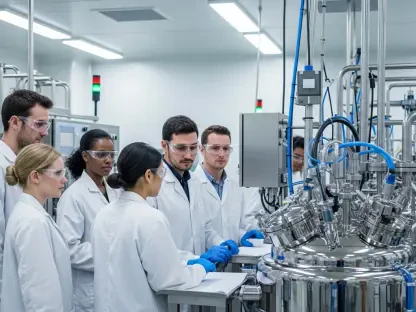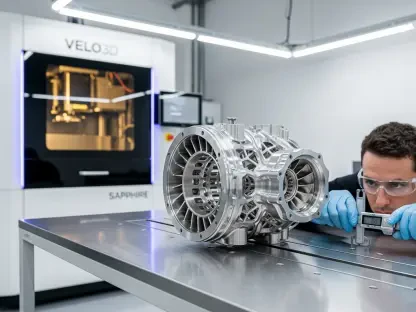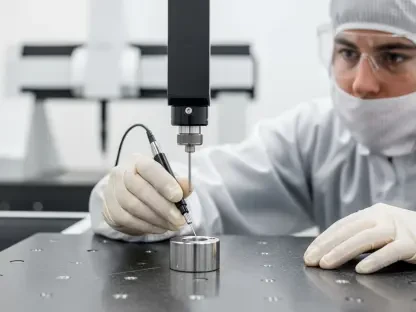In the intricate landscape of healthcare delivery across Australia and New Zealand (ANZ), Baxter Healthcare stands as a pivotal player in ensuring the uninterrupted supply of critical medical products, such as intravenous (IV) fluids, amidst challenges like geographic isolation and global supply chain volatility. With tens of millions of IV fluid bags required annually to support patient care, the stakes couldn’t be higher. As highlighted by Brendan Cummins, Vice President and General Manager for Baxter Healthcare in ANZ, through a detailed feature in Manufacturers’ Monthly, the company is adopting a proactive stance to fortify its supply chain. This involves not just reacting to disruptions but anticipating potential setbacks and adapting swiftly to ensure healthcare providers have consistent access to essential resources. The unique position of ANZ at the far reaches of global supply networks amplifies the risk of delays during crises, whether from natural disasters or sudden demand surges, making resilience a cornerstone of Baxter’s mission.
The complexity of maintaining supply continuity in this region demands a blend of immediate action and strategic foresight. Baxter’s approach encompasses strengthening local production capabilities, integrating advanced technology, and fostering a collaborative culture across its workforce and partners. By addressing both current needs and future uncertainties, the company showcases a deep understanding of the dual nature of supply chain management in healthcare. This comprehensive strategy not only mitigates risks but also positions Baxter as a leader in adapting to the specific logistical hurdles faced by ANZ, ensuring that life-saving products remain available when they are needed most.
Fortifying Local Production for Regional Security
Establishing a Strong Manufacturing Base
At the core of Baxter’s efforts to build supply resilience in ANZ lies its advanced manufacturing facility in Toongabbie, Western Sydney, which produces over 60 million units of IV and irrigation fluids annually. This local production hub grants the company significant control over the entire process, from sourcing raw materials to delivering sterile, ready-to-use products. Such autonomy reduces the inherent risks associated with reliance on international shipping, which can be disrupted by global events or logistical bottlenecks. The ability to scale output quickly during periods of heightened demand, as witnessed in recent surges, underscores the strategic importance of maintaining a regional manufacturing presence that can respond directly to the needs of healthcare providers across ANZ without the delays tied to distant supply lines.
The Toongabbie facility serves as more than just a production site; it acts as a buffer against the vulnerabilities of global supply chains, particularly in a region as geographically isolated as ANZ. Operating at full capacity to meet unprecedented needs, Baxter demonstrates how localized operations enable agility in addressing sudden shortages or spikes in usage. This setup not only ensures a steady flow of critical supplies to hospitals but also builds trust with stakeholders by proving reliability under pressure. The emphasis on regional manufacturing highlights a broader industry trend toward reducing dependency on far-flung suppliers, a move that is especially crucial for healthcare where delays can have dire consequences for patient outcomes.
Strategic Investments and Government Collaboration
Further strengthening its commitment to supply security, Baxter has partnered with the Australian Government on a significant $40 million co-investment to expand the Toongabbie facility’s production capacity. This long-term initiative is designed to prepare for future disruptions by increasing output potential and enhancing infrastructure resilience. Alongside this, short-term measures such as equipment upgrades and rigorous preventive maintenance ensure that current operations remain uninterrupted even under strain. This dual focus on immediate improvements and future readiness reflects a balanced approach to addressing the dynamic needs of the healthcare sector in ANZ, where preparation is as vital as response.
The collaboration with governmental bodies exemplifies the power of public-private partnerships in bolstering critical supply chains. By aligning with national interests to fortify healthcare infrastructure, Baxter not only enhances its own capabilities but also contributes to the broader stability of medical supply networks in Australia. This expansion project signals a proactive stance, aiming to safeguard against potential crises over the coming years, such as from 2025 onward, by scaling resources to match projected demand. Such strategic investments underscore the necessity of forward-thinking policies in healthcare manufacturing, ensuring that essential products like IV fluids are available to support patient care no matter the external challenges faced.
Leveraging Technology for Operational Excellence
Innovating with Automation and Predictive Tools
Baxter’s adoption of cutting-edge technology plays a transformative role in enhancing supply chain resilience across ANZ, with advanced automation and real-time monitoring systems at the forefront of its strategy. By integrating 24/7 sensor data and automated processes, the company can swiftly identify operational anomalies and address them before they escalate into significant disruptions. Additionally, the exploration of artificial intelligence (AI) and predictive analytics offers a forward-looking perspective, enabling Baxter to anticipate risks and optimize workflows. This technological framework ensures that critical products reach healthcare facilities precisely when needed, minimizing the chances of shortages in a region where timely access is paramount.
The impact of these innovations extends beyond mere problem prevention; it fosters a level of transparency and efficiency that is crucial for managing complex supply chains. Predictive tools allow for better forecasting of demand fluctuations, particularly in scenarios of unexpected spikes common to healthcare settings in ANZ. By staying ahead of potential issues through data-driven insights, Baxter can allocate resources more effectively, ensuring a seamless flow of IV fluids to hospitals. This tech-centric approach not only bolsters reliability but also sets a benchmark for how manufacturers can harness digital solutions to navigate the uncertainties of global and regional logistics.
Aligning Efficiency with Environmental Goals
Beyond enhancing operational reliability, Baxter’s technological initiatives also contribute to broader sustainability objectives, demonstrating that efficiency and environmental responsibility can go hand in hand. By utilizing data-driven decision-making to streamline processes, the company reduces waste and minimizes inefficiencies, aligning supply chain improvements with a commitment to greener practices. This balance is particularly relevant in an industry under increasing scrutiny to lessen its ecological footprint while maintaining high standards of service delivery to healthcare providers in ANZ.
The integration of sustainable practices through technology reflects a nuanced understanding of modern manufacturing challenges. For instance, optimizing production schedules with predictive analytics cuts down on energy overuse and material wastage, directly benefiting both operational costs and environmental impact. This dual advantage positions Baxter as a forward-thinking entity that prioritizes long-term benefits alongside immediate supply needs. As healthcare demands continue to evolve, such strategies ensure that resilience is built on a foundation of innovation that serves both patient care and planetary health, addressing multiple stakeholder concerns simultaneously.
Empowering Teams and Partnerships for Collective Strength
Cultivating a Skilled and Adaptable Workforce
A critical component of Baxter’s resilience strategy in ANZ is its investment in human capital, recognizing that technology alone cannot sustain a robust supply chain without skilled individuals to drive it. Through initiatives like the Total Productive Maintenance program, machine operators collaborate closely with maintenance engineers to gain a deeper understanding of equipment, enabling faster troubleshooting and resolution of issues. Continuous training further equips the workforce with the adaptability needed to handle unexpected challenges, ensuring that operations remain agile even during high-pressure situations where IV fluid supply is critical to patient outcomes.
This focus on skill development transforms employees into active problem-solvers rather than mere executors of tasks, fostering a culture of ownership and responsiveness within the company. By prioritizing training tailored to the unique demands of healthcare manufacturing, Baxter ensures that its teams in ANZ are prepared to navigate the complexities of supply disruptions, from equipment failures to sudden demand increases. Such empowerment not only enhances operational efficiency but also builds a resilient human infrastructure capable of supporting the broader mission of delivering life-saving products without interruption.
Building a Network of Trust and Collaboration
Resilience in supply chains, as Baxter demonstrates, extends beyond internal efforts to encompass a wider network of partnerships with suppliers and customers across ANZ. By fostering trust and aligning on shared objectives, the company creates a unified front capable of withstanding disruptions collectively. This collaborative ethos, emphasized by Cummins, ensures that every link in the chain—from raw material providers to healthcare end-users—works in tandem to address challenges, whether they stem from logistical delays or regional crises impacting supply availability.
The strength of these partnerships lies in their ability to amplify Baxter’s reach and responsiveness, creating a ripple effect of reliability throughout the healthcare sector. Regular communication and joint problem-solving with external stakeholders help anticipate potential bottlenecks before they occur, ensuring a smoother flow of critical IV fluids. This network of mutual support reflects an understanding that no single entity can achieve true resilience in isolation; rather, it requires a collective commitment to safeguarding supply continuity, ultimately benefiting patients and reinforcing trust across the entire ecosystem.
Reflecting on a Resilient Legacy
Looking back, Baxter Healthcare’s endeavors to strengthen supply resilience in ANZ reveal a masterful integration of local manufacturing, technological innovation, and human collaboration. The strides made through the Toongabbie facility’s operations and the $40 million expansion with governmental support showcase a dedication to overcoming geographic and logistical hurdles. Meanwhile, the adoption of AI, automation, and a skilled workforce highlights how past investments in both tools and talent fortified the company against disruptions. As the healthcare landscape continues to face uncertainties, the next steps for industry players involve scaling such integrated models, prioritizing regional self-sufficiency, and deepening partnerships to ensure that critical supplies like IV fluids remain accessible. Exploring further advancements in predictive technologies and sustainable practices could pave the way for even greater stability, offering a blueprint for manufacturers to protect patient care in challenging environments.









